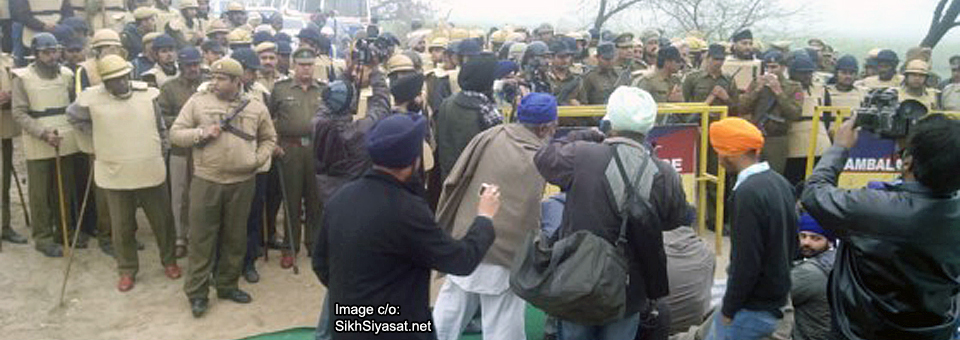It’s been a busy week on social media for “Sikh activists”. First there was the highlighting of an American couple’s decision to walk side-by-side during their Anand Karaj; next came a photograph where a Sikh bride posed sitting behind the Guru Granth Sahib in an empty Darbar; and finally, a video clip of singer Mika Singh giving socialite Paris Hilton a diamond khanda necklace. Each of these incidents has given rise to all manner of ire online and it’s fair to say they’ve gone viral this week, with few Sikhs not having come across them as a result. But as much as these incidents demanded some form of action, perhaps even commentary too, am I the only one who is concerned by the level of attention they received, particularly when we consider the events that go on around us every day without mention?
The first I heard of a Sikh couple’s decision to walk side-by-side around the Guru Granth Sahib during their Anand Karaj was an article published by the website Kaur Life over a week ago. The article focused on why the couple chose to do as they did and quoted heavily from them, generally in a positive tone. Online the reaction was mixed with just as many Sikhs supporting their action as were lambasting them. Funnily enough, I happened to know of the groom in question from his time studying in London and as a bhangra team dancer. He was a pleasant guy and I was quite taken aback by the fact he’d done this because he seemed so non-confrontational! What has surprised me the most (or perhaps it shouldn’t) is how so many people can have an opinion without first ascertaining some facts. Left, right and centre, many Sikhs were at pains to point out that the Anand Karaj was a recent invention – not true – and that it had been sullied by Indian gender bias – again not true. Conversely, there was similar uninformed vitriol directed at the couple suggesting that Sikhs themselves had no right to depart from ceremonial formalities – not true – and that these two must now face some form of punishment – harsh to say the least. In my understanding, if Sikhs gather as a collective and decide to change the way that we celebrate or commemorate the moments of our lives we can do so. This is why the Tenth Guru Nanak bestowed leadership of the Sikhs to both the Guru Granth Sahib and the Guru Panth. However, this is a decision that should be taken as a collective, not by each individual wishing to enact change as they see fit. All of this has been lost in the ensuing melee on Facebook and Twitter and instead we’re left with more confusion than when it all began.
The photograph of a Sikh bride posing most inappropriately sitting at the palki (throne) from which the Guru Granth Sahib is read aloud caused the most stir, being shared thousands of times and commented on repeatedly. The outrage was occasionally profane, which shows both the passion that Sikhs have for their Guru and also the uncivilised manner we have publicly adopted in the World. As with the previous incident, a common suggestion repeated in every comment thread was for the Akal Takht to pronounce a punishment. This was an ill-thought out photo opportunity and was rightly rebuked. It is however just another way in which Sikh culture is used as the backdrop in the ever-increasingly commercialisation of our lives – take for example the kalgi which some foolish Sikh grooms continue to don on their wedding day, or them keeping facial hair and a turban only to be discarded moments after the culmination of the Anand Karaj. The individual in this photo had showed an ignorance that she will never likely have again, the photographer went on record to apologise as soon as she/he understood what they had done, whilst the Gurdwara committee accepted their shortcoming of having left the Darbar empty. Many Sikhs who were upset are now satisfied and have since removed the photo, but I cannot get these demands of punishment from the Akal Takht Jathedar out of my head.
The story of Bollywood singer Mika Singh’s gift of a diamond khanda to American ‘It’ girl Paris Hilton has probably had the least attention online, in part because it happened just a day ago. Again showing considerable ignorance, Mika Singh posted a video of Paris Hilton being given the necklace to his twitter feed, oblivious to how this might be received in certain circles. Of the few social media posts made about it online, one in particular caught my eye (brought to my attention by a friend through Whatsapp) where Mika Singh himself commented multiple times on the status, in the process justifying his action. It’s quite mind-boggling to think that a Sikh can’t see the inappropriateness of a khanda encrusted with diamonds, let alone his gifting of it to somebody as a present, but then finding time to justify it online reminded me of the farcical nature of all three of these incidents this week.
In the bigger scheme of things, none of these three incidents are as important as they have been made out. Of course they need to be highlighted and some form of rectification made where appropriate, but the reaction online was disproportionate beyond belief. I began this article by stating that it had been a busy week for “Sikh activists”. Reacting to these incidents was not Sikh activism. It pains me more than any reader will ever know that thousands of people shared that bride’s photo, that a hundred people deemed it worthy to chime in on putting Mika Singh in his place, or that hundreds have offered their “insights” into the inequality of the laavan (without knowing the origins of it). Where was this viral Sikh activism when Daljit Singh Bittu and Kulbir Singh Barapind – the only credible opposition to the Badal cartel in Punjab – were arrested and incarcerated for over a year before being released without charge? Where are the multitude of comments chastising the Sikh leadership for allowing senior Punjabi politicians to change the words of a hymn without punishment? Where are the shares of those images of Sikh jathedars and scholars attending the personal functions of the RSS leadership? Some might argue that these are Punjab-centric events and so are less likely to entice western-born Sikhs into active protest (albeit online). If that is the case, what of the lack of our opposition to the millions being spent on marble Gurdwara buildings in the west at a time when there is almost no provision for formal education of Sikhi in those areas? Why aren’t we highlighting the appointment of sangat-funded Sikh chairs at Universities and Colleges to scholars who continue to propagate Hew McLeod’s imperialist rendition of Sikhi? And where is the ire against the mainstream media AND some Sikh organisations who continue to promote an untruthful narrative of the events of 1984?
Some Sikhs online wanted the Akal Takht Jathedar to step in on each of these 3 incidents. That statement tells the whole story. We are so far removed from the reality of our circumstances. This is the same Jathedar who bestowed the title ‘faqqar-e-qaum‘ on Punjab’s Chief Minister and Shiromani Akali Dal leader Parkash Badal who himself is the most intelligent and Machiavellian politician that South Asia has seen for centuries. Under his tenure we have witnessed the rapid degradation of Punjab’s environment, a belittling of Sikh values across the Globe and the almost complete eradication of the most important document of our (Punjabi/Sikh) lifetime, the Anandpur Sahib Resolution. But it is much harder to show anger against these villains; it is easier to share a photograph of an unknown Sikh bride from New York disrespecting the Guru Granth Sahib in a regrettable moment, than to highlight any one of the numerous misdeeds of a tyrant who has spent his entire life working towards the destruction of the Panth. It is easier not to question the Akal Takht Jathedar about his lack of response when Guru Granth Sahib birs are set alight and burnt in the heart of the Punjab. It is the easy road of Sikh activism… may I never take the wrong turn on to it.







